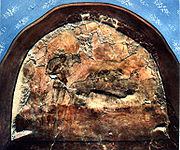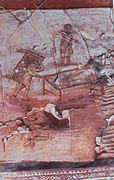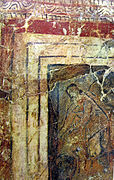- Dura-Europos church
-
The Dura-Europos church (also known as the Dura-Europos house church) is the earliest identified Christian house church. It is located in Dura-Europos in Syria and dates from 235 AD. It is one of the earliest known Christian churches.[1]
Contents
History
The site of Dura-Europos, a former city and walled fortification, was excavated largely in the 1920s and 1930s by French and American teams. Within the archaeological site, the house church is located by the 17th tower and preserved by the same defensive fill that saved the nearby Dura-Europos synagogue.
The building consists of a house conjoined to a separate hall-like room, which functioned as the meeting room for the church. The surviving frescoes of the baptistry room are probably the most ancient Christian paintings. We can see the "Good Shepherd" (this iconography had a very long history in the Classical world), the "Healing of the paralytic" and "Christ and Peter walking on the water". These are considered the earliest depictions of Jesus Christ. [2]
A much larger fresco depicts three women (the third mostly lost) approaching a large sarcophagus. This most likely depicts the three Marys visiting Christ's tomb. The name Salome was painted near one of the women,[citation needed] who is often considered the same person as Mary Mother of James. There were also frescoes of Adam and Eve as well as David and Goliath. The frescoes clearly followed the Hellenistic Jewish iconographic tradition, but they are more crudely done than the paintings of the nearby Dura-Europos synagogue.[3]
Fragments of parchment scrolls with Hebrew texts have also been unearthed; they resisted meaningful translation until J.L. Teicher pointed out that they were Christian Eucharistic prayers, so closely connected with the prayers in Didache that he was able to fill lacunae in the light of the Didache text.[4]
In 1933, among fragments of text recovered from the town dump outside the Palmyrene Gate, a fragmentary text was unearthed from an unknown Greek harmony of the gospel accounts. It was comparable to Tatian's Diatessaron, but independent of it.
Frescoes of the baptistry room The Good ShepherdHealing of the paralyticChrist and Peter walking on waterWomen at the tombThe Samaritan Woman by the WellSee also
- Oldest churches in the world
- Dura-Europos
References
- ^ The people are holy: the history and theology of Free Church worship by Graydon F. Snyder, Doreen M. McFarlane 2005 ISBN 0865549524 page 30
- ^ Graydon F. Snyder, Ante pacem: archaeological evidence of church life before Constantine (Mercer University Press, 2003) http://books.google.com/books?id=swtI9Cpyl3kC&source=gbs_navlinks_s
- ^ F. Snyder, Ante pacem: archaeological evidence of church life before Constantine, (Mercer University Press, 2003)
- ^ J.L. Teicher, "Ancient Eucharistic Prayers in Hebrew (Dura-Europos Parchment D. Pg. 25)", The Jewish Quarterly Review New Series 54.2 (October 1963), pp. 99-109
External links
Categories:- Churches in Syria
- Fresco paintings
- 3rd-century architecture
- Jewish Syrian history
- Roman Empire art
Wikimedia Foundation. 2010.






